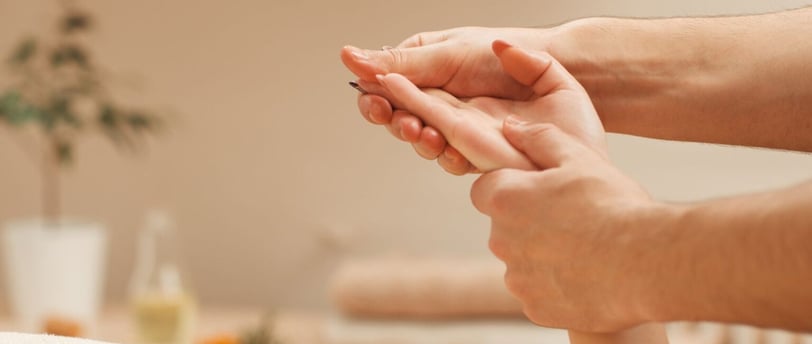The Healing Art of Reflexology: Mapping the Body's Blueprint
Imagine a detailed blueprint of your entire body, not spread across complex diagrams, but intricately mapped onto compact, accessible areas like your feet, hands, and ears. This fascinating concept is the cornerstone of Reflexology, an ancient healing art that views these specific zones as "reflexes" directly corresponding to organs, glands, and systems throughout your body.
7/9/20253 min read


Imagine a detailed blueprint of your entire body, not spread across complex diagrams, but intricately mapped onto compact, accessible areas like your feet, hands, and ears. This fascinating concept is the cornerstone of Reflexology, an ancient healing art that views these specific zones as "reflexes" directly corresponding to organs, glands, and systems throughout your body.
More than just a relaxing massage, reflexology is a holistic practice designed to stimulate the body's natural healing processes, restore balance, and alleviate a wide range of ailments by applying targeted pressure to these reflective maps. It's a journey into understanding your body's intricate connections and empowering its inherent capacity for self-repair and well-being.
The Science Behind Reflexology
Reflexology operates on the principle that different pressure points on the feet, hands, and ears are linked to various parts of the body. For instance, stimulating the toes may correspond to enhancing functions in the brain or sinuses. These pressure points are thought to contain nerve endings that correspond to every organ system, creating an intricate map of the body. As a holistic healing approach, reflexology seeks to restore balance and promote overall well-being by targeting these reflex zones.
The Ancient Origins and Core Principles
The practice of reflexology boasts ancient origins and core principles dating back thousands of years. Evidence suggests its use in ancient Egypt, China, and even among Native American tribes.
The foundational theory, largely popularized in the West by Dr. William Fitzgerald's "Zone Therapy" in the early 20th century and further developed by Eunice Ingham, posits that the body is divided into ten longitudinal zones, running from the head to the tips of the toes and fingers.
Within these zones, specific "reflex points" on the feet, hands, and ears are believed to be energetically linked to every organ, gland, and body part. When pressure is applied to these reflex points, it's thought to stimulate nerve endings, clear energetic blockages (often referred to as 'Qi' in Eastern traditions), and promote the flow of vital energy, thereby encouraging the body's self-healing mechanisms and restoring equilibrium throughout the corresponding areas.
How Reflexology Works: A Holistic View
Understanding how reflexology works: a holistic view involves appreciating its multi-faceted impact on the body. While the exact scientific mechanisms are still a subject of ongoing research, several theories attempt to explain its efficacy.
The most prevalent theory suggests that applying pressure to reflex points stimulates nerve pathways, sending signals to the brain that then prompt responses in the corresponding organs or systems.
Another theory involves the concept of energy flow; blockages in energy pathways are believed to cause discomfort or disease, and reflexology helps to unblock these channels, allowing energy to flow freely.
Additionally, the deep relaxation induced by reflexology can activate the parasympathetic nervous system, countering the effects of stress and promoting the body's natural healing and restorative processes. Some even suggest that it can help break down crystal deposits that accumulate around nerve endings, which are thought to hinder proper nerve function.
The Benefits: From Stress Relief to Pain Management
The diverse range of reported benefits makes reflexology a sought-after complementary therapy, offering everything from stress relief to pain management. One of the most immediate and commonly experienced benefits is profound relaxation, which helps reduce stress and anxiety by calming the central nervous system.
This relaxation, in turn, can improve sleep quality and boost mood. Many individuals report significant pain reduction, particularly for conditions like headaches, migraines, and lower back pain, as reflexology may stimulate the release of endorphins, the body's natural painkillers.
It is also believed to improve circulation, aid detoxification by stimulating the lymphatic system and elimination organs and support the immune system. While it's not a cure for disease, it can be a powerful tool for enhancing general well-being and assisting the body's innate healing abilities.
Exploring Your Body's Maps: Feet, Hands, and Ears
The most commonly utilized reflex maps are found on the feet, but the principles extend to other areas, allowing for exploring your body's maps: feet, hands, and ears. The feet are considered the most sensitive and comprehensive map due to their numerous nerve endings and larger surface area, making them ideal for a full-body treatment.
Specific areas on the soles, tops, and sides of the feet correspond to every part of the body, from the head (toes) to the pelvic area (heels). The hands also contain a similar reflexology map, making hand reflexology a convenient option for self-treatment or when foot access is limited.
Similarly, the ears feature micro-systems that reflect the entire body, with specific points used for various therapeutic purposes. Understanding these maps empowers individuals to engage with their own wellness or seek practitioners skilled in reading and stimulating these intricate bodily blueprints.
Conclusion
Your Body's Map: Unlocking Wellness Through the Ancient Art of Reflexology highlights this remarkable holistic practice as a pathway to deeper understanding and improved health. By recognizing the intricate connections between specific points on the feet, hands, and ears and the body's internal systems, reflexology offers a non-invasive yet powerful means to stimulate healing, reduce stress, manage pain, and restore balance.
Whether you seek profound relaxation, relief from chronic conditions, or simply a deeper connection with your body's innate wisdom, exploring the world of reflexology can be a truly transformative step on your personal journey to optimal well-being.
Reflexology
Therapeutic practice applying pressure specific points hands ears.
Holistic Therapy
Foot Massage
Foot Reflexology
Reflexology massage
Pain relief therapy
Pressure points
© 2024. All rights reserved. Designed by Pimclick - SEO Agency
